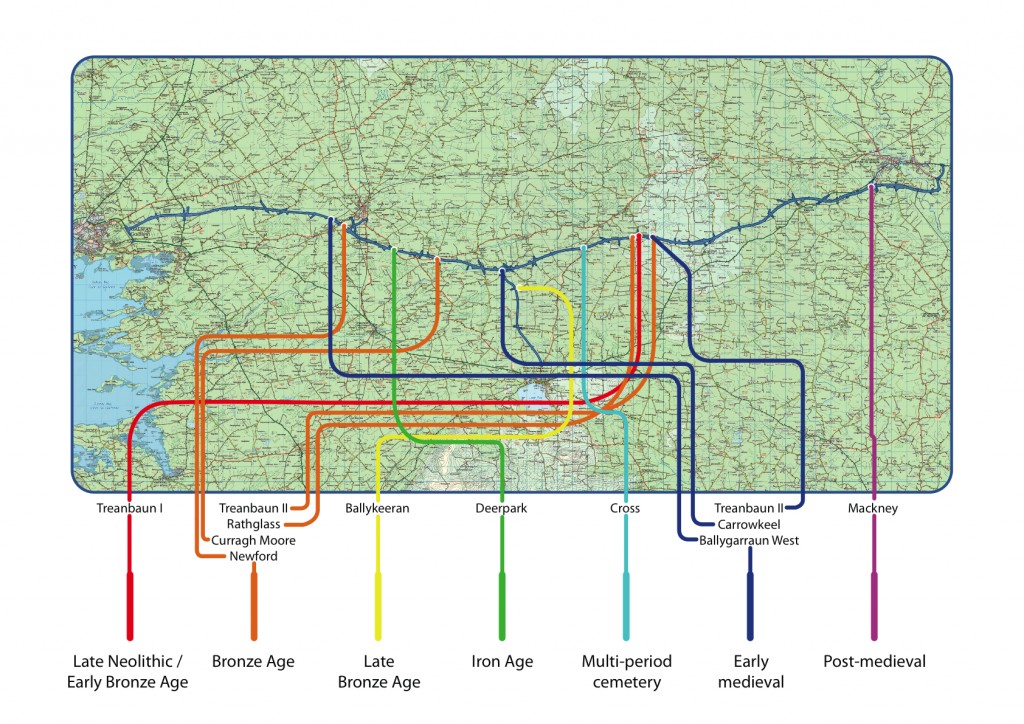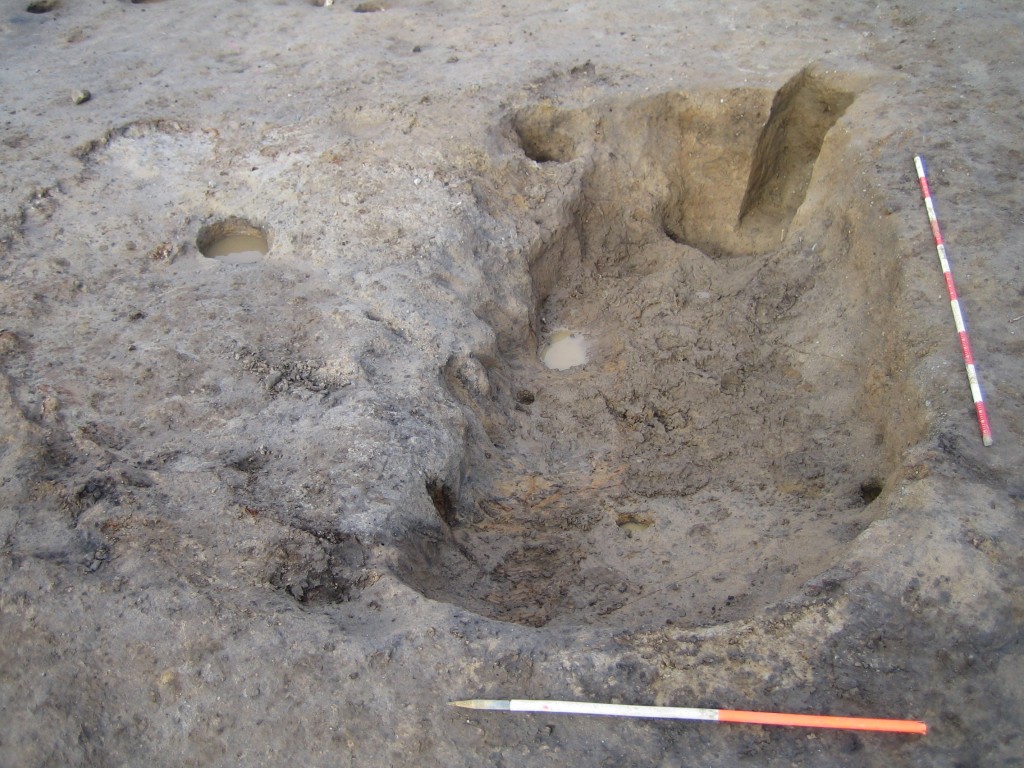The Galway to Ballinasloe N6 road scheme in the Republic of Ireland was 56 km long: metre for metre, one of the largest archaeological projects anywhere in the world. The archaeology found along the scheme has shed new light on the treatment of the dead at crucial stages of Irish history. In the Second of our three part series we assess the evidence.
Rites of passage
 In 1908 Arnold van Gennep published The Rites of Passage and this was a turning point in our understanding of the ritual process. His assessment was that that there are a class of rituals common to all cultures—marriage, initiation, pregnancy, childbirth and death—that follow a distinctive pattern. These ‘rites of passage’ are in effect social mileposts, marking the otherwise intangible crossing of biological thresholds (such as the passage from childhood to adulthood). Applying this model to funerary archaeology enables us to extend the scope of our analysis beyond the moment when physical remains were deposited in the ground. Rites of passage conform to a tripartite scheme characterised by preliminal rites (rites of separation), liminal rites (transitional stage), and post-liminal rites (ceremonies of incorporation into the new state or world).
In 1908 Arnold van Gennep published The Rites of Passage and this was a turning point in our understanding of the ritual process. His assessment was that that there are a class of rituals common to all cultures—marriage, initiation, pregnancy, childbirth and death—that follow a distinctive pattern. These ‘rites of passage’ are in effect social mileposts, marking the otherwise intangible crossing of biological thresholds (such as the passage from childhood to adulthood). Applying this model to funerary archaeology enables us to extend the scope of our analysis beyond the moment when physical remains were deposited in the ground. Rites of passage conform to a tripartite scheme characterised by preliminal rites (rites of separation), liminal rites (transitional stage), and post-liminal rites (ceremonies of incorporation into the new state or world).
 In a traditional Irish funeral, the burial would be performed as a ‘post-liminal’ rite, but the wake takes place during the transitional or ‘liminal’ phase. The word ‘liminal’ derives from the Latin limin meaning threshold; it signifies a dangerous and ambiguous period, perhaps explaining why it is customary during the wake to maintain a constant vigil over the corpse. Excluded from the society of the living but not yet included into the society of the dead, the deceased individual is separated from there past but not yet established in their future identity. They are free from all social categories, and this draws forth a crucial distinction for funerary archaeology between ‘physical’ and ‘social’ death.
In a traditional Irish funeral, the burial would be performed as a ‘post-liminal’ rite, but the wake takes place during the transitional or ‘liminal’ phase. The word ‘liminal’ derives from the Latin limin meaning threshold; it signifies a dangerous and ambiguous period, perhaps explaining why it is customary during the wake to maintain a constant vigil over the corpse. Excluded from the society of the living but not yet included into the society of the dead, the deceased individual is separated from there past but not yet established in their future identity. They are free from all social categories, and this draws forth a crucial distinction for funerary archaeology between ‘physical’ and ‘social’ death.
To the modern mind this may sound fanciful; in this age of science and scepticism ghostly apparitions can be explained away to nothing, but as the prehistoric sites discovered on the M6 demonstrate, the origins of our modern-day funerary behaviour lie in a world where manifestations of death were experienced as profound encounters with another world, seldom seen and never entered by the living.

Prehistoric death
As we turn now to the archaeological evidence, remember these two concepts (primary and secondary burial rites and physical and social death) and we’ll see if they cannot help bring the data to life. The prehistoric sites excavated on the M6 show that cremation was the usual process of disposal of the dead. We usually only find cremation pits, where remains are collected from the pyre and deposited into pits in the ground or funerary vases as part of secondary burial rites. But at Newford we also discovered a Late Bronze Age funerary pyre, one of only a handful of such sites found in Europe. This was really significant for us—the pyre was part of the primary burial rites, and as such it’s a real breakthrough in our understanding.
 It had been constructed above a large pit, 3.5 m long and 2 m wide, that may have aided in the updraft of flames (Illus. 3). The pyre superstructure would have been constructed from firewood, stacked with the body laid on top. This had then collapsed into the pit after burning, with about 700 g of human bone—fragmentary remains of finger bones, teeth and skull bones (Illus. 4). There were also more typical funerary features for this period in Ireland—cremation pits or ‘token cremation burials’ dating to 1114–918 cal. BC-7401; see Appendix 1 for details) that contained such small quantities of bone that researchers have begun to question what’s happening to cremated remains if it’s not all ending up in the ground (Illus 5).
It had been constructed above a large pit, 3.5 m long and 2 m wide, that may have aided in the updraft of flames (Illus. 3). The pyre superstructure would have been constructed from firewood, stacked with the body laid on top. This had then collapsed into the pit after burning, with about 700 g of human bone—fragmentary remains of finger bones, teeth and skull bones (Illus. 4). There were also more typical funerary features for this period in Ireland—cremation pits or ‘token cremation burials’ dating to 1114–918 cal. BC-7401; see Appendix 1 for details) that contained such small quantities of bone that researchers have begun to question what’s happening to cremated remains if it’s not all ending up in the ground (Illus 5).
Here too, the Newford pyre can also shed light.
Modern cremation techniques result in the production of between 1 kg and 3 kg of human bone from an adult body, and from this it has been estimated that archaeological contexts should yield a similar quantity of burnt bone. Using these modern correlates we can infer that at Newford, bone had been removed from the pyre following burning. If only a token quantity of this material was then deposited into cremation pits on the site, the rest of the bone may have been destined for what we now assume to be non-funerary contexts.

An Irish archaeologist called Kerri Cleary outlined the evidence for the occurrence of human bone on Irish Bronze Age settlement sites—house foundations and ritual pits—suggesting that it was deployed as a ‘social artefact’. This sounds like a bizarre practice to us now—but think of all the complex legal arrangements that have to be made when our own loved ones die. Death ruptures the fabric of social relations and it is vital following a funeral that bonds of inheritance are maintained and extended. By using human remains as a ‘social artefact’, this could have been achieved through ceremonial exchange between different groups. Land and belongings could be redistributed, and claims to ancestral territory legitimised through deliberate deposition of these remains in specific locations.
An un-Christian burial at Ballygaraun West
Our second unusual burial belongs to the ‘Early Christian’ period, that is 500 – 850 AD: how far had Christianity really penetrated Irish life? Early Medieval Ireland (500-850 AD) is also known as the early Christian period, as Christianity had become the dominant religion by the 6th century AD. The great transition came in the early Medieval period, when those encounters were challenged by new beliefs that sought to distance themselves from the pagan past and monopolise the passage of the soul. Christian beliefs may well have been the official orthodoxy, but the N6 funerary sites indicate that in some places pagan burial customs were much slower to change.
This is well illustrated by the single, isolated burial excavated at Ballygarraun West by John Lehane for VJK Ltd. The grave was radiocarbon dated to the early-5th to late-7th century AD, a transitionaryl period when Christianity was expanding and consolidating its position as the dominant faith. Christians always buried their dead in consecrated cemeteries,: yet this was a single, isolated burial. The grave was defined by a simple east-west cut 1.5m long and 0.8m wide, and contained the remains of an adult female, estimated to be approximately forty or fifty on the basis of teeth and bone degeneration. However,other features of the inhumation were distinctly pagan. She was lying on a bed of partially carbonised plant material of alder and hazelwood, together with cereal grains such as black bindweed, barley and wheat. This had been scattered into the grave before receiving the body, and a piece of naturally shed antler had been placed over her pubic region.

Whilst the meaning of the Ballygarraun West burial remains elusive, it provides intriguing evidence that the supremacy of the Christian authorities was not yet above challenge. Burning of grain is known from slightly later Anglo-Saxon burials in England, and is interpreted as a symbolic practice associated with purification, an action condemned by the ecclesiastical authorities. If the performance of these rituals was a challenge to the contemporary Church, the isolated location of burial was another bone of contention. Monks, ecclesiastical tenants and sections of the wider community were being encouraged to recognise their affiliation in death through burial at ecclesiastical sites, though a large cemetery site excavated on the N6 indicates a continued use of ancestral burial grounds late into the Medieval period.
Tune in next Friday, when we move forward in time to Carrowkeel, and encounter an early medieval cemetery site where interpretation is much trickier. How well will our anthropological model fare with this site?

